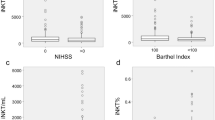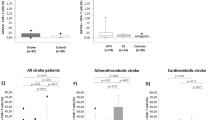Abstract
Purpose
Cerebrovascular complications, including ischemic stroke, account for poor outcomes in patients on hemodialysis. T cell responses may be involved in the pathogenesis of ischemic stroke. We aimed to evaluate the role of naïve T cells in development of ischemic stroke in patients on hemodialysis.
Methods
In this cross-sectional study, 156 patients on hemodialysis in our blood purification center were included. These patients were divided into the ischemic stroke (IS) group (61 cases) and non-ischemic stroke (non-IS) group (95 cases) according to a new diagnosis after initiation of hemodialysis. After being lysed with red blood cell lysis solution, peripheral blood was tested by flow cytometry to detect the expression of CD45RO and CCR7 in CD4 T and CD8 T cells. Correlation analysis and logistic regression analysis were conducted to identify potential independent risk factors for ischemic stroke.
Results
The percentage of peripheral naïve T cells was lower in the IS group [median (interquartile range (IQR)) 13.9% (8.6–22.9%)] compared with the non-IS group [median (IQR) 22.7% (15.9–32.2%), P < 0.001]. Spearman correlation analysis showed that naïve T cells were negatively associated with ischemic stroke (r = −0.308, P < 0.001). Multivariate logistic regression analysis showed that CD4 naïve T cells had an independent negative association with ischemic stroke in patients on hemodialysis (odds ratio 0.933, 95% CI 0.883, 0.986; P = 0.013).
Conclusion
A decrease in percentage of peripheral CD4 naïve T cells is a risk factor for ischemic stroke in patients on hemodialysis.


Similar content being viewed by others
References
Elsharif ME (2011) Mortality rate of patients with end stage renal disease on regular hemodialysis: a single center study. Saudi J Kidney Dis Transplantat 22(3):594–596
Marcelli D, Stannard D, Conte F, Held PJ, Locatelli F, Port FK (1996) ESRD patient mortality with adjustment for comorbid conditions in Lombardy (Italy) versus the United States. Kidney Int 50(3):1013–1018
Goodkin DA (2003) Association of comorbid conditions and mortality in hemodialysis patients in Europe, Japan, and the United States: the dialysis outcomes and practice patterns study (DOPPS). J Am Soc Nephrol 14(12):3270–3277. doi:10.1097/01.asn.0000100127.54107.57
Shiromoto T, Shibazaki K, Iguchi Y, Aoki J, Uemura J, Shimoyama T, Kimura K (2012) Abstract 2510: hemodialysis is a risk factor for short or long term mortality in ischemic stroke patients. Stroke 43(1):A2510
Wang HH, Hung SY, Sung JM, Hung KY, Wang JD (2014) Risk of stroke in long-term dialysis patients compared with the general population. Am J Kidney Dis 63(4):604–611. doi:10.1053/j.ajkd.2013.10.013
Findlay MD, Thomson PC, Fulton RL, Solbu MD, Jardine AG, Patel RK, Stevens KK, Geddes CC, Dawson J, Mark PB (2015) Risk factors of ischemic stroke and subsequent outcome in patients receiving hemodialysis. Stroke 46(9):2477–2481. doi:10.1161/STROKEAHA.115.009095
Betjes MG (2013) Immune cell dysfunction and inflammation in end-stage renal disease. Nat Rev Nephrol 9(5):255–265. doi:10.1038/nrneph.2013.44
Yoon JW, Gollapudi S, Pahl MV, Vaziri ND (2006) Naive and central memory T-cell lymphopenia in end-stage renal disease. Kidney Int 70(2):371–376. doi:10.1038/sj.ki.5001550
Litjens NH, Huisman M, van den Dorpel M, Betjes MG (2008) Impaired immune responses and antigen-specific memory CD4+ T cells in hemodialysis patients. J Am Soc Nephrol JASN 19(8):1483–1490. doi:10.1681/ASN.2007090971
Meijers RW, Betjes MG, Baan CC, Litjens NH (2014) T-cell ageing in end-stage renal disease patients: assessment and clinical relevance. World J Nephrol 3(4):268–276. doi:10.5527/wjn.v3.i4.268
Betjes MG, Meijers RW, Litjens NH (2013) Loss of renal function causes premature aging of the immune system. Blood Purif 36(3–4):173–178. doi:10.1159/000356084
Meijers RW, Litjens NH, de Wit EA, Langerak AW, van der Spek A, Baan CC, Weimar W, Betjes MG (2012) Uremia causes premature ageing of the T cell compartment in end-stage renal disease patients. Immun Ageing 9(1):19. doi:10.1186/1742-4933-9-19
Betjes MG, Meijers RW, de Wit LE, Litjens NH (2012) A killer on the road: circulating CD4(+)CD28null T cells as cardiovascular risk factor in ESRD patients. J Nephrol 25(2):183–191. doi:10.5301/jn.5000057
Betjes MG, de Wit EE, Weimar W, Litjens NH (2010) Circulating pro-inflammatory CD4posCD28null T cells are independently associated with cardiovascular disease in ESRD patients. Nephrol Dial Transplant 25(11):3640–3646. doi:10.1093/ndt/gfq203
Yilmaz G, Arumugam TV, Stokes KY, Granger DN (2006) Role of T lymphocytes and interferon-gamma in ischemic stroke. Circulation 113(17):2105–2112. doi:10.1161/CIRCULATIONAHA.105.593046
Shichita T, Sugiyama Y, Ooboshi H, Sugimori H, Nakagawa R, Takada I, Iwaki T, Okada Y, Iida M, Cua DJ, Iwakura Y, Yoshimura A (2009) Pivotal role of cerebral interleukin-17-producing gammadeltaT cells in the delayed phase of ischemic brain injury. Nat Med 15(8):946–950. doi:10.1038/nm.1999
Hurn PD, Subramanian S, Parker SM, Afentoulis ME, Kaler LJ, Vandenbark AA, Offner H (2007) T- and B-cell-deficient mice with experimental stroke have reduced lesion size and inflammation. J Cereb Blood Flow Metab 27(11):1798–1805. doi:10.1038/sj.jcbfm.9600482
Liesz A, Suri-Payer E, Veltkamp C, Doerr H, Sommer C, Rivest S, Giese T, Veltkamp R (2009) Regulatory T cells are key cerebroprotective immunomodulators in acute experimental stroke. Nat Med 15(2):192–199. doi:10.1038/nm.1927
Aho K, Harmsen P, Hatano S, Marquardsen J, Smirnov VE, Strasser T (1980) Cerebrovascular disease in the community: results of a WHO collaborative study. Bull World Health Organ 58(1):113–130
Litjens NH, van Druningen CJ, Betjes MG (2006) Progressive loss of renal function is associated with activation and depletion of naive T lymphocytes. Clin Immunol 118(1):83–91. doi:10.1016/j.clim.2005.09.007
Grau AJ, Weimar C, Buggle F, Heinrich A, Goertler M, Neumaier S, Glahn J, Brandt T, Hacke W, Diener HC (2001) Risk factors, outcome, and treatment in subtypes of ischemic stroke: the German stroke data bank. Stroke 32(11):2559–2566
Eleftheriadis T, Antoniadi G, Liakopoulos V, Kartsios C, Stefanidis I (2007) Disturbances of acquired immunity in hemodialysis patients. Semin Dial 20(5):440–451. doi:10.1111/j.1525-139X.2007.00283.x
Betjes MGH, Langerak AW, van der Spek A, de Wit EA, Litjens NHR (2011) Premature aging of circulating T cells in patients with end-stage renal disease. Kidney Int 80(2):209–218. doi:10.1038/ki.2011.110
Chen R, Xiang F, Hu J, Cao X, Tan X, Jia P, Zhang T, Song N, Fang Y, Ding X, Zou J (2017) Factors associated with the elevated percentage of CD4CD69 T cells in maintained hemodialysis patients. Ren Fail 39(1):547–554. doi:10.1080/0886022X.2017.1349672
Eleftheriadis T, Kartsios C, Yiannaki E, Kazila P, Antoniadi G, Liakopoulos V, Markala D (2008) Chronic inflammation and T cell zeta-chain downregulation in hemodialysis patients. Am J Nephrol 28(1):152–157. doi:10.1159/000110020
Eleftheriadis T, Papazisis K, Kortsaris A, Vayonas G, Voyatzi S, Vargemezis V (2004) Impaired T cell proliferation and zeta chain phosphorylation after stimulation with staphylococcal enterotoxin-B in hemodialysis patients. Nephron Clin Pract 96(1):c15–c20. doi:10.1159/000075567
Brinkkoetter PT, Marinaki S, Gottmann U, Fleckenstein S, Stump C, Van Der Woude FJ, Braun C, Yard BA (2005) Altered CD46-mediated T cell co-stimulation in haemodialysis patients. Clin Exp Immunol 139(3):534–541. doi:10.1111/j.1365-2249.2005.02705.x
Eleftheriadis T, Yiannaki E, Antoniadi G, Liakopoulos V, Pissas G, Galaktidou G, Stefanidis I (2012) Plasma indoleamine 2,3-dioxygenase and arginase type I may contribute to decreased blood T-cell count in hemodialysis patients. Ren Fail 34(9):1118–1122. doi:10.3109/0886022X.2012.713297
Eleftheriadis T, Antoniadi G, Liakopoulos V, Stefanidis I, Galaktidou G (2012) Plasma indoleamine 2,3-dioxygenase concentration is increased in hemodialysis patients and may contribute to the pathogenesis of coronary heart disease. Ren Fail 34(1):68–72. doi:10.3109/0886022X.2011.623562
Eleftheriadis T, Liakopoulos V, Antoniadi G, Stefanidis I, Galaktidou G (2011) Arginase type I as a marker of coronary heart disease in hemodialysis patients. Int Urol Nephrol 43(4):1187–1194. doi:10.1007/s11255-010-9842-4
Sun Z, Ye H, Tang B, Shen X, Wu X, Zhong H, Song W (2013) Prevalence of circulating CD4(+)CD28(null) T cells is associated with early atherosclerotic damage in patients with end-stage renal disease undergoing hemodialysis. Hum Immunol 74(1):6–13. doi:10.1016/j.humimm.2012.08.001
Hendrikx TK, van Gurp EA, Mol WM, Schoordijk W, Sewgobind VD, Ijzermans JN, Weimar W, Baan CC (2009) End-stage renal failure and regulatory activities of CD4+CD25bright+FoxP3+T-cells. Nephrol Dial Transplant 24(6):1969–1978. doi:10.1093/ndt/gfp005
Belayev L, Liu Y, Zhao W, Busto R, Ginsberg MD (2001) Human albumin therapy of acute ischemic stroke: marked neuroprotective efficacy at moderate doses and with a broad therapeutic window. Stroke 32(2):553–560
Wu MP, Lin HJ, Weng SF, Ho CH, Wang JJ, Hsu YW (2014) Insomnia subtypes and the subsequent risks of stroke: report from a nationally representative cohort. Stroke 45(5):1349–1354. doi:10.1161/STROKEAHA.113.003675
Acknowledgements
We acknowledge the precious help provided by the Yubin Zhang from the School of Public Health Fudan University. We thank Ellen Knapp, Ph.D., from Liwen Bianji, Edanz Group China (www.liwenbianji.cn/ac), for editing the English text of a draft of this manuscript. This study was founded by the Shanghai Committee of Science and Technology, China (Grant No. 15DZ0503402), and the National Natural Science Funds of China (No. 81430015).
Author information
Authors and Affiliations
Corresponding authors
Ethics declarations
Conflict of interest
All authors have no conflicts of interest, and there are no relationships with industry.
Ethical approval
All procedures performed in studies involving human participants were in accordance with the ethical standards of the institutional and/or national research committee and with the 1964 Declaration of Helsinki and its later amendments or comparable ethical standards.
Informed consent
Informed consent was obtained from all individual participants included in the study.
Electronic supplementary material
Below is the link to the electronic supplementary material.
Rights and permissions
About this article
Cite this article
Chen, R., Hu, J., Xiang, F. et al. Decreased percentage of peripheral naïve T cells is independently associated with ischemic stroke in patients on hemodialysis. Int Urol Nephrol 49, 2051–2060 (2017). https://doi.org/10.1007/s11255-017-1691-y
Received:
Accepted:
Published:
Issue Date:
DOI: https://doi.org/10.1007/s11255-017-1691-y




